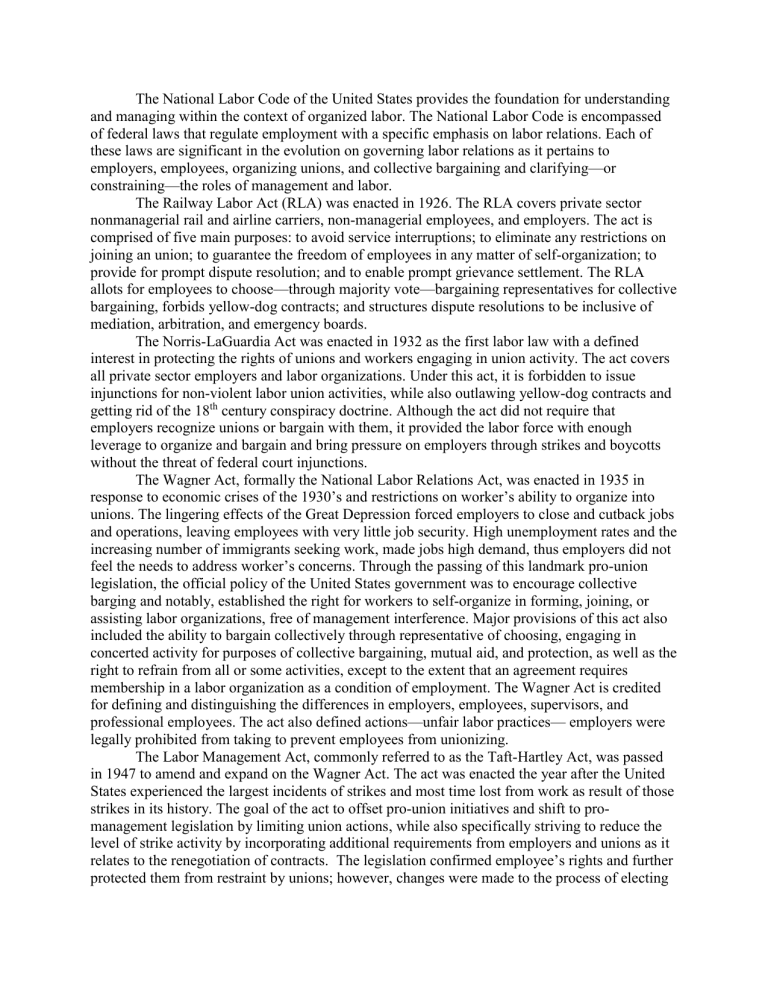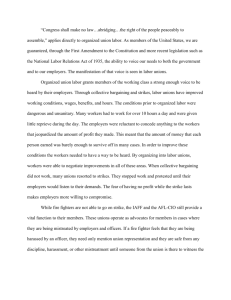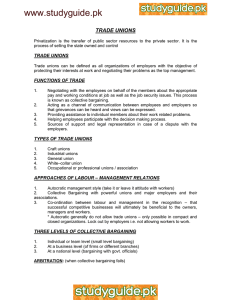
The National Labor Code of the United States provides the foundation for understanding and managing within the context of organized labor. The National Labor Code is encompassed of federal laws that regulate employment with a specific emphasis on labor relations. Each of these laws are significant in the evolution on governing labor relations as it pertains to employers, employees, organizing unions, and collective bargaining and clarifying—or constraining—the roles of management and labor. The Railway Labor Act (RLA) was enacted in 1926. The RLA covers private sector nonmanagerial rail and airline carriers, non-managerial employees, and employers. The act is comprised of five main purposes: to avoid service interruptions; to eliminate any restrictions on joining an union; to guarantee the freedom of employees in any matter of self-organization; to provide for prompt dispute resolution; and to enable prompt grievance settlement. The RLA allots for employees to choose—through majority vote—bargaining representatives for collective bargaining, forbids yellow-dog contracts; and structures dispute resolutions to be inclusive of mediation, arbitration, and emergency boards. The Norris-LaGuardia Act was enacted in 1932 as the first labor law with a defined interest in protecting the rights of unions and workers engaging in union activity. The act covers all private sector employers and labor organizations. Under this act, it is forbidden to issue injunctions for non-violent labor union activities, while also outlawing yellow-dog contracts and getting rid of the 18th century conspiracy doctrine. Although the act did not require that employers recognize unions or bargain with them, it provided the labor force with enough leverage to organize and bargain and bring pressure on employers through strikes and boycotts without the threat of federal court injunctions. The Wagner Act, formally the National Labor Relations Act, was enacted in 1935 in response to economic crises of the 1930’s and restrictions on worker’s ability to organize into unions. The lingering effects of the Great Depression forced employers to close and cutback jobs and operations, leaving employees with very little job security. High unemployment rates and the increasing number of immigrants seeking work, made jobs high demand, thus employers did not feel the needs to address worker’s concerns. Through the passing of this landmark pro-union legislation, the official policy of the United States government was to encourage collective barging and notably, established the right for workers to self-organize in forming, joining, or assisting labor organizations, free of management interference. Major provisions of this act also included the ability to bargain collectively through representative of choosing, engaging in concerted activity for purposes of collective bargaining, mutual aid, and protection, as well as the right to refrain from all or some activities, except to the extent that an agreement requires membership in a labor organization as a condition of employment. The Wagner Act is credited for defining and distinguishing the differences in employers, employees, supervisors, and professional employees. The act also defined actions—unfair labor practices— employers were legally prohibited from taking to prevent employees from unionizing. The Labor Management Act, commonly referred to as the Taft-Hartley Act, was passed in 1947 to amend and expand on the Wagner Act. The act was enacted the year after the United States experienced the largest incidents of strikes and most time lost from work as result of those strikes in its history. The goal of the act to offset pro-union initiatives and shift to promanagement legislation by limiting union actions, while also specifically striving to reduce the level of strike activity by incorporating additional requirements from employers and unions as it relates to the renegotiation of contracts. The legislation confirmed employee’s rights and further protected them from restraint by unions; however, changes were made to the process of electing representatives, with the most notable change excluding supervisors from inclusion in the bargaining unit. Congress added new types of elections, specifically giving union members the right to hold elections to deauthorize and decertify unions, effectively introducing the possibility of reversing the process of representation. Other major provisions of this law also allowed states to enact right-to-work laws and granted employees the freedom to reject union membership. Furthermore, this legislation also identified unfair labor practices possibly committed by the union as lawmakers acknowledged that employers may not be the sole party in violating employee rights. In 1959, the Landrum-Griffin Act, formally known as the Labor-Management Reporting and Disclosure Act (LMRDA), was passed after congressional hearings into corrupt practices in labor-management relations, such as embezzlement of funds, and efforts to protect the democratic rights of union members. Major provisions of the act included specifying and guaranteeing individual rights of union members through the requirement of a Bill of Rights for union members, prohibiting certain management and union conduct, and creating a requirement of union financial disclosures detailing all receipts and distributions of funds, along with a breakdown of payments made for all activities. The act made it a requirement for unions to file constitutions, bylaws and annual reports with the Secretary of Labor. The Wagner, Taft-Hartley, and Landrum-Griffin Acts are now known as the Labor Management Relations Act. These acts establish a statutory preference for using collective bargaining to resolve conflicts in employment relationships in conjunction with balancing the power of management and labor. In addition to individual provisions stated in their legislation, as a collective, major provisions include both labor and management must bargain in good faith; expanding unfair labor practices to include discrimination for union activities, secondary boycotts, and refusal to bargain; and established procedures for national emergency disputes. In 1962, President Kennedy issued Executive Order 10988 that was groundbreaking for federal employee unions. Major provisions of the executive order enabled a majority union to bargain collectively with a government agency; negotiations restricted to terms and conditions of employment only; and a clause that unions could not represent employees if they advocated strikes or the right to strike. Title VII of the Civil Service Reform Act of 1978 was enacted to regulate labor management relations in the federal service by codifying the provisions written in previous Executive Orders. Major provisions of this act include the ability for employees to choose representatives for collective bargaining; bargaining rights established for noneconomic and nonstaffing issues; and necessary arbitration of unsolved grievances.


